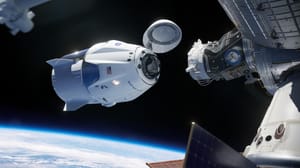
Aug 29, 2024
The Unusual Crew-9 Mission
Set to launch no earlier than September 24 atop a Falcon-9 is SpaceX's ninth Commercial Crew Program mission and will become the company's 15th crewed flight when it launches. Every crewed mission is special, but this mission will be a little more interesting than usual.
The Crew
Crew-9 was originally planned to include NASA astronauts Stephanie Wilson as mission specialist, Nich Hague as the pilot, and Zena Cardman as the spacecraft's commander, as well as Roscosmos cosmonaut Aleksandr Gorbunov as the flight engineer.

This has changed due to recent problems such as helium leaks and thruster failures with Boeing's Starliner capsule. NASA is not confident in Starliner's ability to bring the two astronauts it transported to the ISS, Butch Wilmore and Suni Williams, back home safely.
This means that Butch and Suni have to return in another capsule, that being the Crew-9's Dragon, Freedom. The Crew Dragon only has four seats, and because of NASA's seat barter agreement with Roscosmos, we know that Aleksandr Gorbunov's seat is secured and his role will most likely be upgraded to pilot of the spacecraft. This will be the first time a Russian has piloted Dragon.
As to what two crew members will have to wait for their turn to fly, it is currently unknown, but rumor has it that it will most likely be Hague and Wilson, as Cardman's role as commander is essential for the mission's success.
Launch Pad
Because of Starliner's extended stay at the ISS, the Crew-9 mission, originally slated to launch on August 18th, was pushed back to September 24th so NASA could decide what to do with Starliner. This is because Starliner is docked to the Harmony module's forward port, which Crew-9 will also dock to.
This delay also meant that the Crew-9 launch would suddenly come too close to NASA's Europa Clipper mission's 21-day launch window in October, which is also planned to launch from LC-39A. Another delay in Crew-9 could cause the launch to slip into October and prevent Europa Clipper from reaching its intended Jupiter orbit.
To avoid these scheduling conflicts, the Crew-9 mission was moved to SLC-40, which will be the first crewed launch from this pad as it received its crew access arm and other crew capabilities in November 2023.
Falcon-9
SpaceX's workhorse and 75% reusable rocket Falcon-9 will be carrying out the heavy part of the mission: getting out of the thicker atmosphere. The current Block 5 version of Falcon-9 debuted in 2018, while Falcon-9 goes way back to 2010.

With its nine open-cycle kerolox Merlin engines and a single vacuum-optimized Merlin on the upper stage, the Falcon-9 has earned its status as one of the most reliable and cheapest rockets ever to fly.
By landing its reusable booster on one of SpaceX's three drone ships or making a return-to-launch-site landing, it enables the company to increase launch cadence and reduce the cost of going to space. With more launches, SpaceX also gets more data on their vehicle for safer travel and better performance.
Booster
Since Crew-5, SpaceX has used new boosters with no flight record for CCP missions. This is set to change on this flight, as B1085 will take the two astronauts to space. The booster has previously launched Starlink Group 10-5.
NASA spokesperson Stephanie Schierholz stated the following in 2020 after the Demo-2 mission:
SpaceX has proposed to reuse future Falcon 9 and/or Crew Dragon systems or components for NASA missions to the International Space Station because they believe it will be beneficial from a safety and/or cost standpoint.
Crew-2, Crew-3, and Crew-4 would then go on to be launched with the reused boosters B1061, B1067, and B1067, respectively, as well as Inspiration4, Axiom-1, Axiom-3, and soon, Polaris Dawn with B1062, B1062, B1080, and 1083, respectively.
Launch
Falcon-9 will first accelerate Dragon to about 6,000 km/h at an altitude of ~70 km. After stage separation, the second stage will take over and further accelerate the crew to an orbital velocity of ~28,000 km/h on the ISS' 51,6° orbital inclination, while the booster will land at Landing Zone 1 in Cape Canaveral after its boostback, entry, and then landing burn.

Dragon will then catch up with the ISS and make small positional changes with the Draco RCS thrusters. Docking with the ISS will then take place. First a soft capture and then a hard capture where power and data can be transferred to Dragon.
Return
The crew will stay onboard the ISS, where they will conduct science experiments, perform spacewalks, maintain the station, etc., until February 2025, when the two Crew-9 astronauts will undock, but they will be accompanied by two other astronauts, Butch and Suni.
Dragon will most likely be carrying a couple of extra IVA suits for the two Boeing astronauts, as these suits help cool the astronauts during re-entry, adjust the air mixture they breathe, and shield the astronauts in case of an emergency.
Crew-9 may become the final crew to splash down in the Atlantic Ocean, as SpaceX will be moving those operations to the West Coast in the future. This is due to some trunk pieces previously having crashed down in Australia and North Carolina. The new deorbit trajectory will hopefully prevent this issue.
To Summarize...
It will always be exciting to see more humans roaming the cosmos, and new challenges will inevitably be faced at times, but that is part of evolving as a species. Good thing that some of the brightest people in the world are working together on whatever issues may arise.
We wish Crew-9, whoever they may be, a safe journey to space and thank them for their involvement in growing humanity's dominance over the sky and beyond.
In memory of Booster 1062. Fly high.



